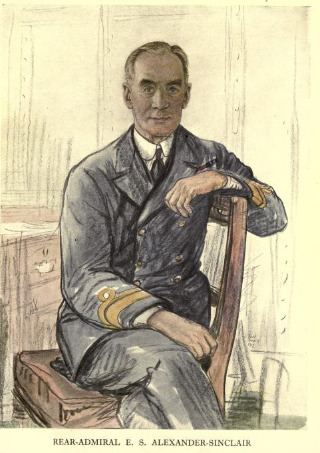Allegiance United Kingdom Died November 13, 1945 | Name Edwyn Alexander-Sinclair Years of service 1879-1930 Rank Admiral | |
 | ||
Commands held HMS Albatross (1902-04)HMS Surprise (1904-05)Royal Naval College, Osborne (1905-08)HMS Victory, (1911-13)HMS Temeraire (1913-15)1st Light Cruiser Squadron, (1915-17)6th Light Cruiser Squadron, (1917-20)1st Battle Squadron, Atlantic Fleet, (1922-24)China Station, (1925-26)Nore Command, (1927-30) Awards GCB, MVO, Order of St. Vladimir (Third Class) with swords Similar People Walter Cowan, Augustus Agar, Nikolai Kuzmin, Fyodor Raskolnikov, Johan Pitka | ||
Admiral Sir Edwyn Sinclair Alexander-Sinclair GCB MVO (1865 – 13 November 1945) was a British Royal Navy officer, notable for firing the first shots of the Battle of Jutland, and for leading a squadron of light cruisers in the Baltic to support independence of Estonia and Latvia in 1918–1919.
Naval career
Born in Malta, Edwyn Sinclair Alexander-Sinclair joined the Royal Navy as a cadet in 1879 at the age of 14, becoming a midshipman 2½ years later. He was made lieutenant in 1890, and served as flag-lieutenant to both Admiral Tracey and Admiral Sir Michael Culme-Seymour, gaining promotion to commander in January 1901. He then had two sea commands, the destroyer Albatross from February 1902 serving at the Mediterranean Station from May that year; and after paying her off in January 1904, the despatch vessel Surprise until 1905.
Alexander-Sinclair was promoted to captain in 1905, and was appointed commander of the Royal Naval College, Osborne, serving there until 1908, when he received the MVO. Between May 1911 and August 1913 he was captain of HMS Victory, the flagship of the Commander-in-Chief, Portsmouth.
In 1914, at the start of World War I, Alexander-Sinclair was captain of the dreadnought HMS Temeraire, before flying his flag in HMS Galatea from 1915 as commodore of the 1st Light Cruiser Squadron. He received the CB for his part in the destruction of Zeppelin L 7 on 4 May 1916. On 31 May 1916 it was the 1st Light Cruiser Squadron under Alexander-Sinclair that first engaged scouting vessels of the German High Seas Fleet and signalled "enemy in sight", leading to the Battle of Jutland, after which he received a Mention in Despatches from Vice-Admiral Sir David Beatty, commander of the Battlecruiser Fleet, and the Russian Order of St. Vladimir (Third Class) with swords. Promoted to rear admiral in 1917, he then commanded the 6th Light Cruiser Squadron, flying his flag in HMS Cardiff. In November 1918 Alexander-Sinclair was given the honour of leading the surrendered German Fleet into internment at Scapa Flow, and awarded the KCB.
Soon afterwards, in December 1918, Alexander-Sinclair's 6th Squadron was sent to the Baltic, at the request of Estonian Government, to take part in the Estonian War of Independence. They delivered 6,500 rifles, 200 machine guns and two field guns. The British squadron also captured two Russian destroyers, Spartak and Avtroil, and turned them over to Estonia, which renamed them Vambola and Lennuk. Alexander-Sinclair then blockaded the Russian Navy base at Kronstadt until relieved by the 1st Light Cruiser Squadron under Rear-Admiral Walter Cowan. He was Admiral-Superintendent of Portsmouth Dockyard from 1920 to 1922, and then as a vice admiral, commanded the 1st Battle Squadron, Atlantic Fleet from 1922 to 1924, before serving as Commander-in-Chief, China Station from 1925 to 1926, and after promotion to admiral, as Commander-in-Chief, The Nore from 1927 to 1930. He retired in 1930.
